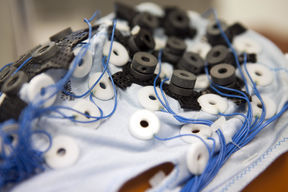Can EEG and machine learning predict respiratory difficulties in Covid19 patients?

In the most serious cases of coronavirus infection, vital body functions can fail either slowly or suddenly. In both situations intensive care is essential, but current possibilities in recognizing patients who ultimately end up in intensive care are limited. Early identification of high-risk patients and the possible upgrading of treatment can, in the best of cases, prevent respiratory problems from getting worse.
HUS Helsinki University Hospital is launching a study together with Aalto University to see if serious respiratory problems among coronavirus patients can be predicted by using electroencephalography (EEG).
‘Our research may show if the disease can directly affect the respiratory centre of the central nervous system, thus contributing to the development of serious breathing difficulties. Our ultimate aim is to find patients at risk of developing respiratory difficulties before the symptoms set in, and to direct them to intensive care in time’, says Hanna Renvall, head of the BioMag laboratory at the HUS Diagnostic Center.
Using EEG to find biomarkers
The two-year study will begin in January 2021. The researchers will record EEGs in coronavirus patients who suffer from a shortage of oxygen and those who do not, and compare them with EEGs of a control group. Both groups include 75 patients from HUS and Kuopio University Hospital.
The researchers will examine a large amount of data, searching for an ‘EEG fingerprint’ that could be used as a biomarker to predict the development of respiratory difficulties. A biomarker refers to a characteristic of a disease, which may indicate the illness, help in making a more precise diagnosis, or help in following the course of a disease.
‘Few other hospitals have the resources needed for this kind of scientific research or the computational knowledge required for machine learning. The development of this research knowledge benefits all types of intensive care’ Hanna Renvall says.
The SARS-CoV2 virus is known to attach to “ACE2 receptors” which have also been found in nerve cells. In theory, the virus could thus alter the function of the respiratory centre in the central nervous system in such a way that the change could leave an identifiable fingerprint in the EEG.
This study is connected with Hanna Renvall's more extensive research project, funded by the Academy of Finland, with the goal of expanding diagnostics and predictions in neurological diseases by developing computational modelling that can be utilised in functional brain imaging.
Further information:
Hanna Renvall
Master of Science in Technology, Doctor of Medicine
Director of the BioMag Laboratory, HUS Diagnostic Centre
Department of Neuroscience and Biomedical Engineering, Aalto University
hanna.renvall@hus.fi, hanna.renvall@aalto.fi
tel. +358 40 703 6161
Riitta Salmelin
Professor
Department of Neuroscience and Biomedical Engineering, Aalto University
riitta.salmelin@aalto.fi
tel. +358 50 344 2745
Original press release published on the HUS website 23 September [Finnish Language Only].
Read more news

Your voice gives away valuable personal information, so how do you keep that data safe?
With speech technologies becoming increasingly common, researchers want to make sure we don’t give away more information than we mean to.
Aalto in 2025: Quantum leaps, creative breakthroughs and solutions for a better life
Growth, technology and industrial renewal; human-centred solutions; health and everyday wellbeing; and enjoyable daily life and thriving communities.
Research Council of Finland establishes a Center of Excellence in Quantum Materials
The Centre, called QMAT, creates new materials to power the quantum technology of coming decades.






